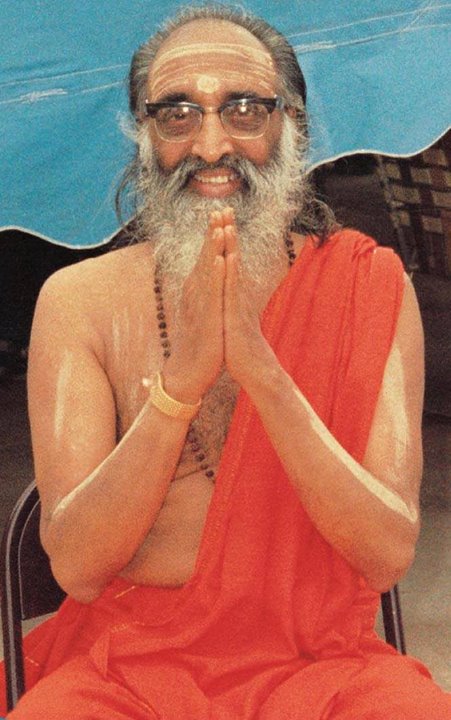Gita : Ch-10. Slo-20.
Srimad Bhagavad-Gita :
Chapter-10. ( Vibhuthi-yogam )
Slokam-20. ( I am the Self, O Guḍakesa, seated in the hearts of all creatures. I am the beginning, the middle and the end of all beings.)
ahamatma gudakesa sarvabhutasayasthitah,
ahamadisca madhyam ca bhutanamanta eva ca.
gudakesa = hey Arjuna
sarva bhutasaya sthitah = situated within all living entities;
atma aham = I am the Atma;
bhutanam adi ca madhyam ca = the beginning ( the origin ), and the middle;
antah ca aham eva = and the end Me only.
In this slokam Arjuna is addressed as Gudakesa, which means one who has conquered the darkness of sleep.
For those who are sleeping in the darkness of ignorance, it is not possible to understand how the Supreme Godhead manifests Himself in the material and spiritual worlds.
Thus this address by Krishna to Arjuna is significant. Because Arjuna is above such darkness, the Personality of Godhead agrees to describe His various opulences.
Krishna first informs Arjuna that He is the Self or soul of the entire cosmic manifestation by dint of His primary expansion.
Before the material creation, the Supreme Lord, by His plenary expansion, accepts the Purusha incarnations, and from Him everything begins.
Therefore He is Atma, the soul of the mahat-tattva, the universal elements.
The total material energy is not the cause of the creation, but actually the Maha-Vishnu enters into the mahat-tattva, the total material energy.
He is the soul.
When Maha-Vishnu enters into the manifested universes, He again manifests Himself as the Supersoul in each and every entity.
We have experience that the personal body of the living entity exists due to the presence of the spiritual spark.
Without the existence of the spiritual spark, the body cannot develop.
Similarly, the material manifestation cannot develop unless the Supreme Soul of Krishna enters.
The Supreme Personality of Godhead is existing as the Supersoul in all manifested universes.
A description of the three purusha-avataras is given in Srimad-Bhagavatham.
"The Supreme Personality of Godhead manifests three features, as Karanodakasayi Vishnu, Garbhodakasayi Vishnu and Kshirodakasayi Vishnu, in this material manifestation."
The Supreme Lord Krishna, the cause of all causes, lies down in the cosmic ocean as Maha-Vishnu or Karanodakasayi Vishnu, and therefore Krishna is the beginning of this universe, the maintainer of the universal manifestation, and the end of all the energy.
Before Lord Krishna commences speaking of His transcendental glories He describes His glorious divine spiritual form.
The words sarva-bhutasaya- sthitah means abiding in the heart of all sentient beings.
How?
As paramatma the Supreme Soul residing within the atma or individual soul which all collectively comprise His transcendental, spiritual body.
The Supreme Lord Krishna is the beginning meaning creation, the middle meaning sustenance and the end meaning destruction of all living entities along with all insentient elements.
The Supreme Lord uses the address Gudakesa meaning one who has control over sleep which indicates that Arjuna has the ability to be ever wakeful and aware.
Now commencing Lord Krishna describes the nature of His Supreme Divinity commencing with the reality that He is the Supreme Soul residing in the etheric heart of all sentient beings as monitor of all their thought and actions.
Then He reveals that He is the sole cause of all living entities in existence which includes their beginning or origin, their middle meaning their continuance and their ending which means dissolution.
Within the etheric hearts of all living entities is enthroned the atma or eternal soul which comprises the spiritual body of the Supreme Lord Krishna.
To be the eternal atma is to be in every respect the support, the ruler and controller of the living entities and to be blessed with the atma is to be eternally connected to the Supreme Lord lifetime after lifetime forever.
The Brihadaranya Upanisad V.VII.XV beginning yas sarvashu bhuteshu tishthan sarvebhyo bhutebhyo states :-
He who is enthroned in the heart of all beings, Who is the innermost of all beings, Whom all the beings know not, Whom all beings form His spiritual body, Who rules the interior of all beings, is the atma, the antaryami the immortal inner ruler.
In the same Upanishad V.VII.XXII beginning ya atmani tisthan atmano it states : -
He who is enthroned within the atma, Who resides within the interior of the atma, Whom even the atma does not know, Whom all atma's are the spiritual body, Who rules the interior of the atma is paramatma the Supreme atma of all.
So enthroned as such within the atma of all living entities as paramatma the Supreme Lord is the beginning, the middle and the end of all beings and their cause, their evolution and their dissolution.
So now that it has been shown how the Supreme Lord abides within all His manifested beings as the atma and how all terms regarding the atma in their ultimate reference samanadhi-karanya which means two or more terms signifying different ideas but referring to a singular object connotes the Supreme Lord Himself.
Such references concerning the relationship between the Supreme Lord and His manifested creation will be illustrated by many notable examples.
Verily only then do all such terms have the ultimate connotation as referring to the Supreme Lord when He is residing within as the eternal atma.
For example the terms of demigod, human, animal, tree etc. although denotative of the corporeal exterior, is connotative of the eternal soul which indwells within those exterior forms.
The same rule holds true in regard to terms ultimately connotative in referring to the Supreme Lord in His aspect as the eternal soul of all living things as well.
Movable or immovable nothing exists without the Supreme Lord Krishna and so all are dependent upon the Him.
To be continued ...





Comments
Post a Comment